Last night my wife and kids were out of town so I did what any husband and father might do with an evening alone. I put on my headlamp and gardened in the darkness. I planted tomatoes and tomatillos, and then I sowed a row of corn, and then I scouted around for insects.
Truth is, I garden at night here and there throughout the year, even when the family is home. But during hot spells like the one we had last week, I particularly choose the night in which to get yard chores done. After sunset I don’t have to wear long sleeves or a hat; it’s much cooler and the work is less sweaty.
Smooth transplanting
Also, nighttime is ideal for transplanting. You can pop the plants out of the trays and lay them in their spots, roots exposed, and be in no rush to get them into the ground and watered since there’s no sun beaming on them. Once in the ground, the plant roots have all night to get acquainted with their new soil situation before needing to pull up water to support their leaves at sunrise.
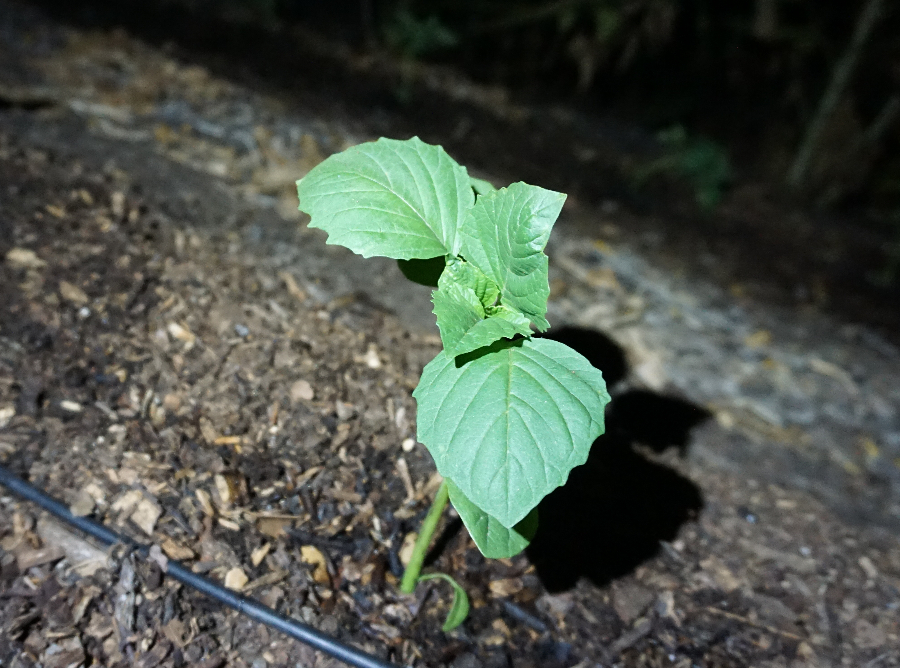
Nocturnal companions
There are many other pleasantries for you, the gardener, to experience at night compared to day. It’s usually quiet at night. At the same time, partly because your vision is limited, you end up hearing more animals. Last night I heard crickets and coyotes mostly. I was listening for owls but didn’t hear any.
Other nocturnal creatures that you can’t hear can be seen in your spotlight. Last night, after I was finished planting and sowing, I walked over to my orange tree and found pill bugs munching on fallen oranges.
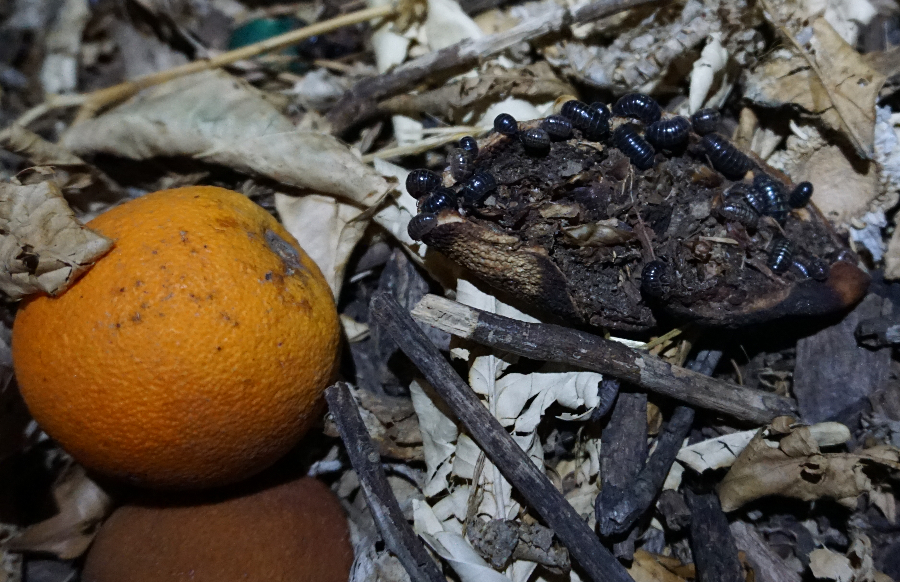
On previous nights I’ve found them munching on my cucumbers along with earwigs.
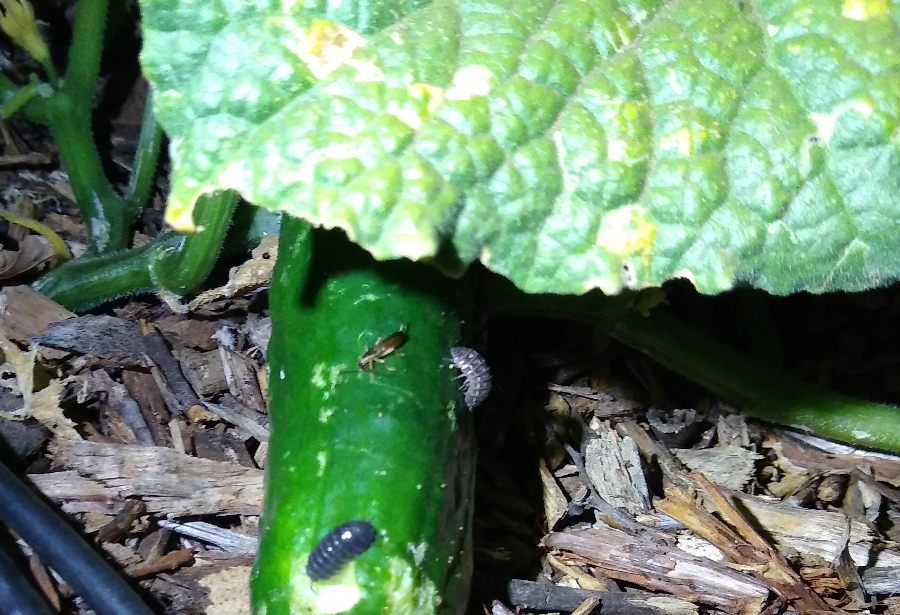
If you’re seeing chew damage on vegetables or if you’re seeing holes in the leaves of your vegetable plants or fruit trees, it’s likely that the feeding is happening after dark, and going out with a flashlight is the only way to know. That’s when you’ll find June bugs chewing holes in avocado leaves here in the early summer, for instance, as I also did last night.

Certain things glisten in the illumination of your flashlight or headlamp. A rabbit’s eyes show red. A spider’s eyes show green. And the guttation on the edges of the leaves of plants like corn show as silver balls.
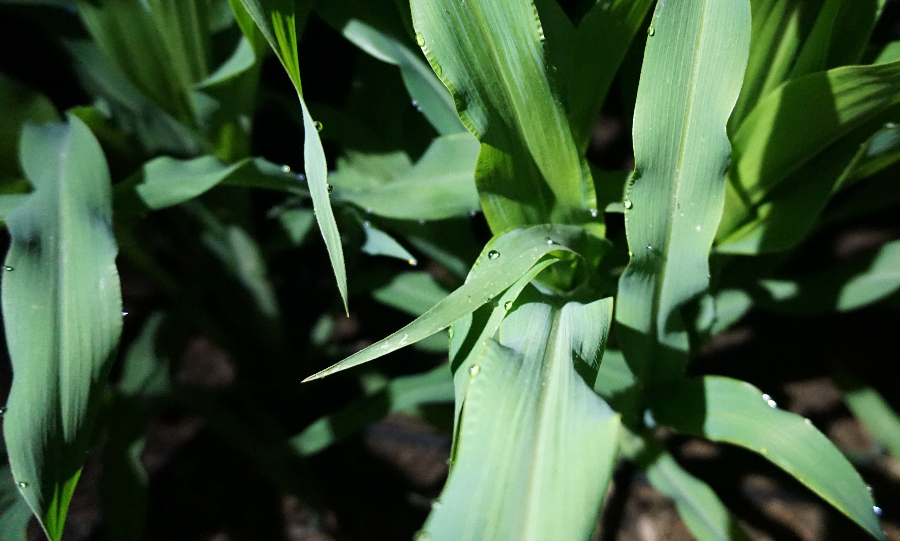
I’ve been told that some animals get their hydration by drinking this water that is exuded by some plants at night. I’ve also been told it tastes sweet. I tasted the liquid drops on the corn last night, but it just tasted like water.
Flying insects
I saw green lacewings fluttering throughout the yard last night. They glow light green in your beam. They are said to be predators of aphids, thrips, psyllids, scales, whiteflies, leafhoppers, spider mites, mealybugs, and more pests — so I always appreciate seeing them, but they’re a bit shy and were hard to capture in a photo.
Moths, on the other hand, can be annoyingly friendly as they flit around your face, attracted to the light on your forehead. I’m told they pollinate dragon fruit flowers though, and it is only at night that dragon fruit flowers are open in full glory. Here’s one I photographed a couple years ago:

Meanwhile, other flying insects sleep at night. Just before I turned in around 11 PM I found a squash bee already snoring inside a pumpkin flower.
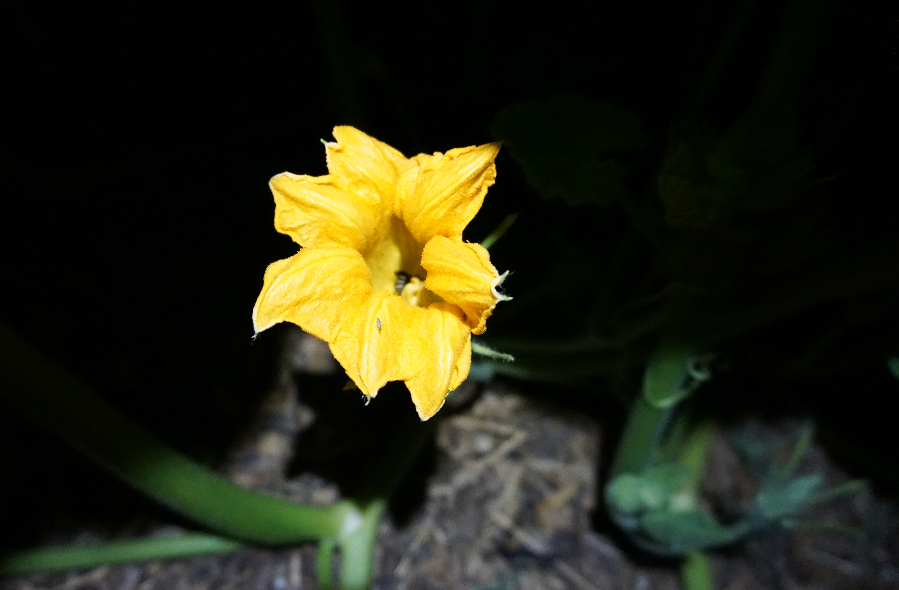
So if you find yourself wanting to take a break from tending your garden under the hot summer sun, or if you’d like to experience a whole new set of animals and sights out there, the night awaits.
Look, Mom: No ads! That’s because generous gardeners like you who read my Yard Posts also support the website. Learn more HERE
All of my Yard Posts are listed HERE

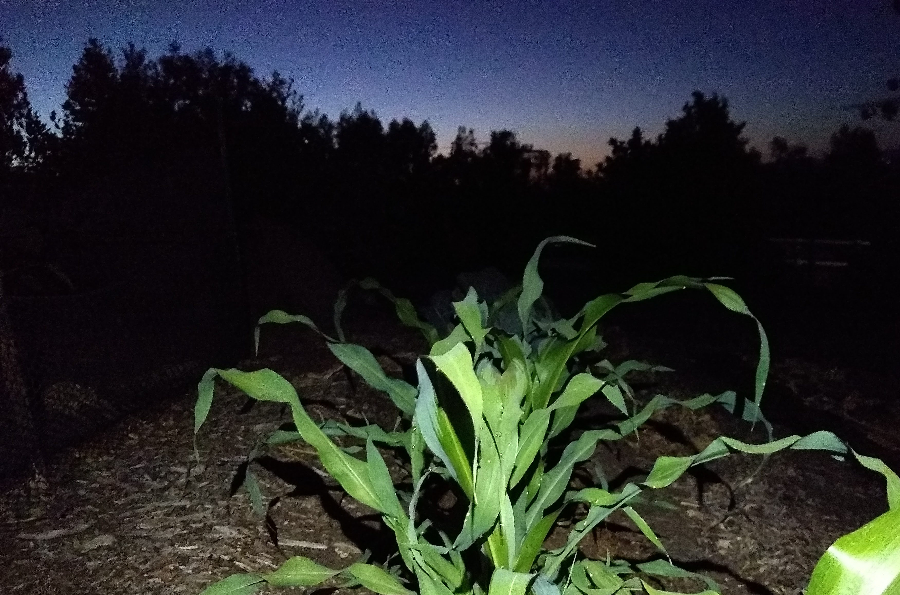


I’ve gardened at night. Any normal gardener will, because it’s so exciting. Does a writer stop writing at night? Of course not!
In one night, snails can do a lot of damage. I don’t tolerate snails. They are an introduced species in Southern California. The product Sluggo or the generic equivalent truly removes them. They appear to be cannibalistic and eat the Sluggo.
Hi Greg,
I have been following your Yard Posts for some time now. You are my go to about Southern California Gardening, I just love your post’s they inspire me. Have you ever or do you ever give talks either on zoom or in person?
Kind Regards,
Teresa Porter
Hi Teresa,
I do give talks sometimes. For example, a couple of weeks ago I spoke at the California Garden Clubs conference about fitting fruit trees into your landscape.
Love the read! Interesting even here in Central Illinois.
Greg,
First, you’re a maniac. I can easily imagine you poking around the garden for an hour in the dark… which makes me chuckle and smile
Second, my favorite line of the month: “There you go, little tomatillo.”
Third, your yard posts have really grown into something wonderfully useable, motivating, and entertaining for Southern California home gardeners. We owe you, and it’s nice to be able to help fund you through the donation page. Much better than fighting through a bunch of adds.
Thanks, Mr. Jeff. Maniac at your service.
HI, FIRST TRY. I PLANTED A RED POTATO IN A 5 GAL CONTAINER. WHEN THE TOP DIED. I DUMPED THE CONTAINER. I ONLY GOT 5 VERY SMALL POTATOES. I WATERED EVERY OTHER DAY. WHAT DID I DO WRONG?
Hi Mickie,
Lots of possibilities, but one is that a five-gallon container is not very big so I wouldn’t expect maximum production from a potato plant in one. Another possibility is that the timing wasn’t ideal. I always get best production from potatoes planted in February.
Hi Greg – I’m covered in insect bites (mostly mosquito + some nasty flies) for being out in the garden in the afternoon and after dusk here in Sonoma Valley so unfortunately I can’t follow you down this rabbit hole 😉 I’m a magnet for insects in any country and there isn’t enough Benadryl to address the problem. But it was a fun read and a vicarious trip.
Hey Greg,
That bug looks like the asiatic beetles that attack my trees… Are you sure it’s a June bug? I have issues with asiatic beetles in my yard especially on my cherry trees. I go out a couple of times a week at night from mid May through early July to pick them off. I always wonder if their grubs are causing root damage as well.
Hi Peter,
People use the term June bug for different animals, but I’m talking about these Phyllophaga species here: https://www.britannica.com/animal/June-beetle
I don’t know what an asiatic beetle is (by that name, anyway). Does it eat the leaves or fruit on your cherry trees?
The asiatic beetles only eat the leaves. They fly to the underside of the leaves as soon as it starts getting dark. I’ve found them on other fruit trees but they seem to prefer cherry. They are brown and smaller than the June bugs that also show up and if you shine a light on them the reflection has a bit of green shine. They are related to Japanese beetles I believe. Last year before Identified them, they ganged up one one of my cherry trees and ate all of the leaves.
OK, Mariangela. You are definitely exempted. I do feel lucky to be in a place with very few mosquitoes.
I relate to your daytime heat here in central Texas.
June was hottest in years – 21 consecutive days
100+. Various snakes coming into lawns from the
Park. no rattlers this year yet! Tomatoes finished.
You win, Tom. I only had one week straight of 100+. I’m guessing you get started on your tomatoes as early as possible in the year in order to get production before high heat sets in? I know some Arizona gardeners who do that.
Hi Greg, What an interesting read about your evening jaunts. Hoping I can ask an Avo question here and I hope we are not too late. We purchased a 15 gal Lamb Hass in December from a grower. It was planted in an amended bed where dwarf citrus grow. We came across your site a couple months later and began following your watering schedule (which was pretty close to what we were doing). Blooms and new leaves came and went. The leaves always looked burned and would drop off quickly and a couple teeny avos dropped off. After a few rounds of this, the tree started looking very sad. We called the grower and they suggested doubling the water. We did that twice and now there are no leaves or flowers, and the tips of most branches are turning dark. We fear this is root rot and are totally bummed. Would love to hear your thoughts on this when you can. Thank you.
Hi Michelle,
If the leaves always looked burned, it makes me think the tree wasn’t getting enough water. Were you applying the water right next to the trunk from day one (as is necessary for a newly planted avocado)? Are there other plants nearby that might be stealing the water you’re giving to the avocado? (Maybe the citrus are.)
Hi Greg,
Thank you for responding. The closest citrus (dwarf navel orange) is 9 feet away. We did water the rootball area but also about a 1 foot area surrounding the rootball. Maybe not enough water went to the rootball specifically? Should we still concentrate on that now – 7 months later? We just gave this guy a drink and we will get back on your watering schedule and hope for new growth and no root rot! Any additional information is welcome. Appreciate your willingness to help. Thanks again.
Hi Greg, Long time reader, First time writer.
Just wanted to thank you. You’re my first stop anytime I want to plant something.
I’m from the east coast, an avid gardener with 4 seasons. So coming here – you are a blessing.
Thanks for taking the time to write that, Liz. I’m grateful.
I just found your site as I was headed out to plant some potatoes. Thanks to your advice I will wait a couple more weeks.
I do grow tomatoes but have tough skins this year. Is that due to my watering schedule?
This is the first year I have had to water by hand and I do not know what I am doing.
Have large yield .
I live In Irvine with clay like soil. But I use lots of amendments to compensate.
Hi Wendy,
I get tough skin on some of my tomatoes sometimes and I know that one factor is variety. Some varieties just always have thicker, tougher skins. But another that I suspect is heat and/or intense sun. Often it’s in mid or late summer that I notice skins getting tougher so I associate this with the higher heat and sun intensity, but I haven’t seen any formal studies to confirm this.
I’ve never noticed my watering schedule correlating with the skin toughness, but I wouldn’t rule it out.
You might try adding a light shade, like 30 percent, over the plants during days above 90 in order to see if that makes a difference.